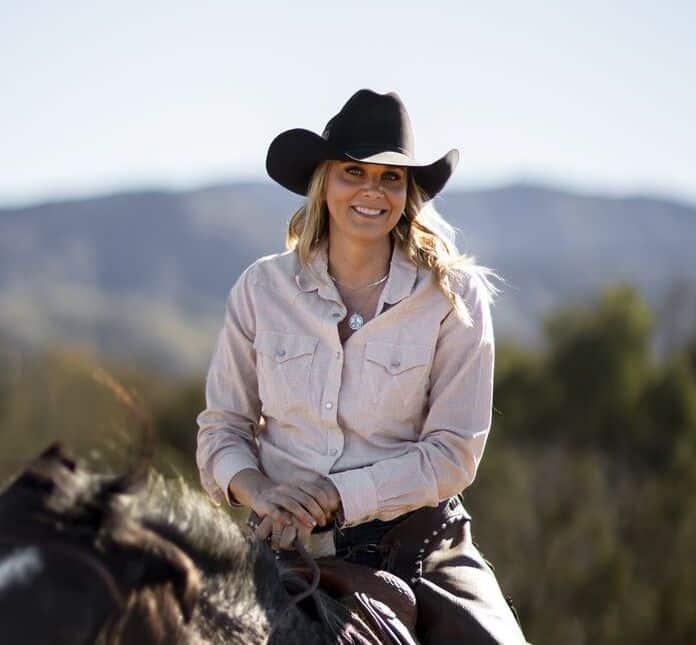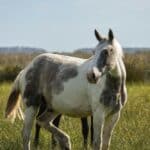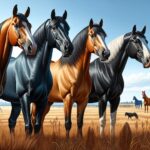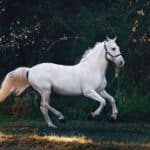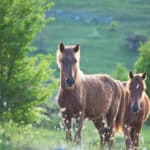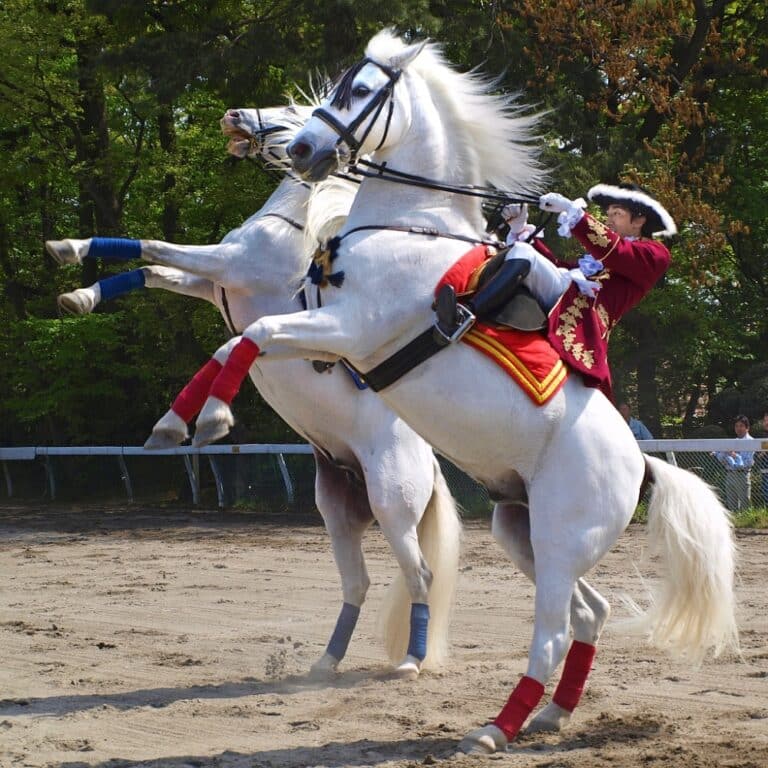Horse coat colors offer an intriguing palette of beauty, stemming from their genetic makeup, which plays a pivotal role in the vast array of horse colors and markings seen in different breeds. Understanding the horse colors chart involves delving into how horse coat colors are determined by two basic pigments: black and red, signaling a fascinating aspect of equine genetics where the ability to reproduce these pigments is inherited. Genetic traits weave a complex tapestry, with red being recessive to black, highlighting not just the diversity but the genetic principles underpinning rare horse colors and the more common hues. This foundational knowledge sets the stage for exploring the beautiful horse colors that captivate enthusiasts and professionals alike.
Moving forward, the article will guide readers through a rich spectrum encompassing not just horse color names but also horse coat patterns that define the visual identity of each equine. From the elegance of black, the warmth of chestnut, to unique horse coats like palomino or the rarest horse color, and even including the intricate horse colors and markings of pinto and Appaloosa patterns, each section offers insights into the genetic wonders behind different colors of horses. This exploration not only promises to enhance understanding of horse coat genetics but also to celebrate the awe-inspiring beauty and diversity found within the equine world.
The Basics of Horse Color Genetics
Horse coat colors are primarily determined by two basic pigments: black and red, which are influenced by various genes and their alleles. The Extension (E) locus gene is crucial as it allows for the expression of black pigment, while the Agouti (A) locus gene controls where black appears on the horse’s coat, predominantly affecting the base color to create shades like bay. These genetic interactions are essential for producing the rich variety of horse colors observed.
The dilution genes, such as the cream gene, play a significant role in modifying these base colors to produce lighter or different hues. For example, the Palomino color results from a single allele of the cream gene acting on a red base coat, leading to a golden color due to incomplete dominance. Similarly, other dilution genes like dun, champagne, and silver dapple lighten existing coat colors, adding complexity to the genetic landscape of equine coat colors.
Patterns of white, including gray, roan, and pinto, are influenced by additional genes. The gray gene, for instance, causes a progressive loss of pigment, turning the horse’s coat gray, and is a dominant trait. Roan horses exhibit a mix of white and colored hairs, a trait governed by a dominant gene symbolized by the Rn allele, leading to a consistent pattern across generations. These genetic factors collectively contribute to the diverse and striking array of horse coat colors and patterns, each with its genetic blueprint.
Black
Black horses are distinguished by their fully black hair coat, devoid of any reddish or brownish hairs, accompanied by black skin and dark brown eyes. These horses may exhibit pink skin under any white markings, which can lead to blue eyes if the white markings cover one or both eyes. Interestingly, even two black horses can produce a chestnut foal if each carries a recessive chestnut gene, showcasing the complexity of equine genetics.
Newborn black horses initially display a mouse-gray coat, which they shed to reveal their true black color as they mature. However, exposure to the sun can cause their coats to bleach, giving them a bay or seal brown appearance, although those without sun bleaching are referred to as “true” blacks. True black horses are genetically characterized by at least one dominant extension gene (EE or Ee) and lack other dominant genes that modify color. The definitive identification of a true black horse requires genetic testing.
Black horses, particularly the Friesians, are renowned for their jet-black coats and are highly admired for their striking beauty and elegance. Black stallions, known for their intelligence and athleticism, often exhibit spirited, courageous, and loyal personalities. These horses require regular grooming to maintain their distinct appearance and manage various shades of black and unique markings. Black is a foundational color in the equine world, serving as one of the two base colors from which all other horse colors are derived, and is dominant over chestnut.
Bay
Bay horses are primarily recognized by their rich reddish-brown or brown body color, which is beautifully contrasted by black points. These points typically include the mane, tail, ear edges, and lower legs, distinctly setting them apart from other horse colors. This coloration is a result of the agouti gene which restricts the black pigment to these specific areas, allowing the redder hues to dominate the body.
Interestingly, while some foals are born displaying the bay color, they may carry a dominant gene for graying, which leads them to progressively turn gray as they age. This transformation shows the dynamic nature of horse coat colors influenced by genetic factors. Additionally, bay horses can be confused with chestnuts due to their similar reddish body coat. However, unlike chestnuts, bays always possess the characteristic black points.
Bay horses are not only common in various horse breeds but also exhibit a wide range of shades and patterns due to the influence of other equine coat color genes. This genetic variation can result in different appearances such as buckskin, perlinos, bay duns, amber champagne, silver bays, bay roan horses, bay pintos, sabino, bay leopards, and rabicano. Such diversity is seen in breeds like Clydesdales, Thoroughbreds, Quarter Horses, Tennessee Walking Horses, Arabians, and Andalusians, which are known to commonly have bay-colored horses. Despite the aesthetic appeal of the bay coloring, its market value does not differ significantly from other colors, with prices largely dependent on the horse’s breed, ranging on average from $500 to $10,000.
Chestnut
Chestnut horses are characterized by their captivating reddish-brown coat, which can appear in a variety of shades from light sandy chestnut to the deep, rich tones of liver chestnut. This color spectrum includes red chestnut, often referred to as sorrel, and flaxen chestnut, which showcases lighter mane and tail. The skin of these horses is predominantly black, although it may present lighter hues at birth, gradually darkening as they age.
Interestingly, the terms “chestnut” and “sorrel” are used interchangeably in different regions, though they describe the same coloration. The term “sorrel” is derived from the sorrel plant found in Eurasia and has been historically prevalent in European equine descriptions. Both chestnut and sorrel horses share the same genetic makeup, emphasizing that the distinction is largely based on regional preference rather than genetic differences.
Genetically, chestnut is one of the base colors in horses, resulting from recessive genes that influence the entire coat to display the red pigment without any black points. This color remains consistent throughout the horse’s life, unlike other colors such as roan, which may change over time. The chestnut color has been a part of the equine genetic palette since shortly after domestication, showcasing its longstanding significance in horse color genetics.
Gray
Gray horses exhibit a unique transformation in their coat color as they age, starting from any base color. Initially, the graying process is often noticeable around the eyes and muzzle and progressively spreads to the rest of the body. This change can begin as early as the first year of life, with the rate of graying varying significantly among individual horses. Some may turn completely gray within a few years, while others might take longer, with the transformation extending over decades.
These horses may be born any color, and interestingly, if a black foal is destined to turn gray, it is typically born jet-black. As gray horses mature, their coats lighten, often passing through stages that might include dappled patterns or a roan-like appearance with intermixed light and dark hairs. Eventually, most gray horses achieve a coat that is predominantly white, although some retain patches of their original color. It’s crucial to note that a gray horse always has black skin underneath its coat, except under any white markings that are present at birth, distinguishing them from truly white horses, which have pink skin.
The genetic mechanism behind this fascinating color shift involves the gray gene, which causes a gradual depigmentation of the hair shaft. Over several years, this gene leads to an increase in white hairs, eventually giving the horse a white or nearly white appearance. This genetic trait is prevalent in several horse breeds, notably those with Arabian lineage, such as the Lipizzan, Andalusian, and Arabian horses themselves. Despite their elegant and often striking appearance, gray horses are at a higher risk for developing melanomas, with studies indicating that as many as 80% of gray horses over the age of 15 may develop this condition.
Palomino
Palomino horses, renowned for their striking golden coats and contrasting light manes, are not a specific breed but rather a color phenotype that can appear in various horse breeds. This color is the result of a chestnut base coat influenced by a single allele of the cream dilution gene, which lightens the red pigment to a golden shade. Historically, the allure of Palominos can be traced back to the Golden Horde of Genghis Khan, where they were highly esteemed.
These horses typically range in height from 14.2 to 16 hands and are characterized by a well-muscled build and a refined head with a gentle expression, traits that complement their aesthetic appeal and make them favorites in various equestrian disciplines. Known for their intelligence and a pleasing disposition, Palominos are often chosen for both competitive and recreational riding, owing to their ability to form strong bonds with their handlers and their versatility in performance.
In the United States, the beauty and distinctiveness of Palominos have led to the establishment of dedicated color breed registries, such as the Palomino Horse Association (PHA) and the Palomino Horse Breeders of America (PHBA), which ensure the preservation and promotion of this eye-catching color. Their popularity peaked during the mid-20th century, often featured in films and parades, which has sustained a lasting fascination with this unique coat color.
Buckskin and Dun
Buckskin and Dun horses exhibit captivating color variations due to specific genetic influences, presenting a spectrum from golden hues to distinctive primitive markings. Buckskin horses, characterized by their pale cream to golden tan body, are essentially bay horses with a single dose of the cream dilution gene, which primarily affects the red pigmented areas, leaving the black points on the mane, tail, ears, and lower legs untouched. These horses often display a frosting effect on the mane and tail, adding to their striking appearance.
Dun horses, on the other hand, possess a light-colored body but are distinguished by a darker dorsal stripe running down their back, darker legs, and often additional markings like leg barring and a mask on the face. This unique appearance is due to the dun gene, which interacts with both black and red pigments, diluting the coat color while preserving the darker dorsal stripe, mane, tail, and primitive markings. These markings can include zebra striping on the legs, shoulder stripes, and darker ear tips, which are indicative of the horse’s genetic heritage and often linked to ancient origins.
Distinguishing between Buckskin and Dun horses can be challenging without genetic testing, as both can exhibit similar color dilutions and markings. However, the presence of a dorsal stripe is a definitive feature of Dun horses, absent in Buckskins. Additionally, Dun horses may show a range of base coat colors including bay, black, and chestnut, each affected by the dun factor which imparts a striped or dappled appearance, enhancing their rugged beauty.
Roan
Roan horses exhibit a distinctive coat color pattern, which involves an even mixture of white and colored hairs across the body, giving them a striking, silvery appearance. Unlike other horse colors, the roan pattern is present from birth, although it may not become fully apparent until after the foal sheds its initial coat. This unique coloration does not affect the “points” of the horse—the mane, tail, lower legs, and head—which generally remain solid in color, providing a beautiful contrast to the lighter body.
The genetic mechanism behind the roan coloration involves a modifier that scatters white hairs throughout the horse’s coat. This modifier acts on the base color of the horse, adding complexity to the genetic landscape of equine coat colors. Roan horses can be born with any base color, and the intermingling of white hairs does not change with age, unlike some other color patterns such as gray.
In terms of visibility, the roan pattern is consistent across the horse’s body but noticeably absent on the points, which retain a deeper, solid color that complements the lighter, speckled body. This consistent yet dynamic interplay of colors makes roan horses particularly appealing and easily distinguishable in various equine populations.
Pinto and Appaloosa Patterns
Pinto and Appaloosa horses are celebrated for their distinctive and colorful coat patterns, each breed bringing its own unique genetic and visual characteristics to the equine world. Pinto horses are known for their large patches of white and another color on their coat, typically displaying patterns such as tobiano, sabino, splashed white, frame, and manchado. These patterns are visually and genetically distinct from the spotting patterns characteristic of horse breeds such as the Appaloosa. The Pinto Horse Association of America (PtHA) recognizes only two of the four acknowledged types of conformation: tobiano and overo, with tovero representing a combination of these patterns.
Appaloosa horses, on the other hand, boast a unique spotted pattern that includes a white or roan base coat peppered with dark spots. These patterns can range from dark or white spots, blankets, and “varnish” on a darker base color, to less uniform borders in width and placement compared to Pinto patterns. The skin under Appaloosa patterns is often dark or primarily dark, and when wet, may reveal a blanket pattern on the skin. The distinctive features of Appaloosas include mottled skin, white sclera in their eyes, striped hooves, and the presence of the Leopard-complex (Lp) gene responsible for these spotting patterns.
Both Pinto and Appaloosa horses contribute significantly to the diversity and beauty of horse colors and patterns. While Pintos can be from a variety of breeds, ranging from Thoroughbred to Miniatures, and are also classified and registered according to their size, Appaloosas exhibit a wide range of body types with heights varying from 14 to 16 hands and weights ranging from 950 lbs to 1,250 lbs. These breeds not only enhance the aesthetic diversity within the equine community but also embody a rich genetic heritage that continues to fascinate horse enthusiasts and geneticists alike.
Conclusion
Exploring the remarkable world of horse colors offers a glimpse into the fascinating interplay between genetics and the beauty of these majestic animals. From the foundational blacks and chestnuts to the stunning diversity of palominos, duns, and the intricate patterns of pintos and Appaloosas, each color and pattern not only adds to the visual tapestry of the equine world but also tells a story of genetic heritage and evolution. This journey through the spectrum of horse coat colors underscores the complexity of equine genetics, highlighting how alleles interact to create the rich variety observed in breeds around the globe.
As we close this exploration, it becomes evident that the study of horse colors is more than an aesthetic pursuit; it is a window into the biology and history of these beloved animals. The information presented not only enriches our appreciation for the visual beauty of horses but also invites further research and discovery in equine genetics. Whether for a prospective owner, a breeder, or simply an equine enthusiast, understanding the intricacies behind horse colors enhances our connection to these animals and reminds us of the roles they have played across cultures and history.
FAQs
1. What is the most uncommon horse color?
The rarest horse color is white. True white horses have white hair and pink, mostly unpigmented skin. Unlike the more common gray horses that appear white, true white horses are born with their distinctive color and maintain it throughout their life.
2. What are the primary colors found in horses?
Horses primarily come in three colors: chestnut, bay, and black. These colors result from the genetic interaction between the Melanocortin 1 Receptor (MC1R) and Agouti Signaling Protein (ASIP) genes.
3. Which horse color is most frequently seen?
The most popular horse color is bay. Bay horses have a brown body with black points, including the mane, tail, muzzle, lower legs, and ear rims. This coloration is the base color for many horse breeds.
4. Can you list the four horse colors mentioned in biblical references?
In biblical contexts, four horse colors are mentioned, each symbolizing different concepts:
- White Horse: Often represents Christ, the Gospel, or the Holy Spirit.
- Red Horse: Symbolizes empire division.
- Black Horse: Associated with imperial oppression.
- Pale Horse: Represents the destruction of an empire. These interpretations are primarily derived from Christological perspectives and other biblical references.

